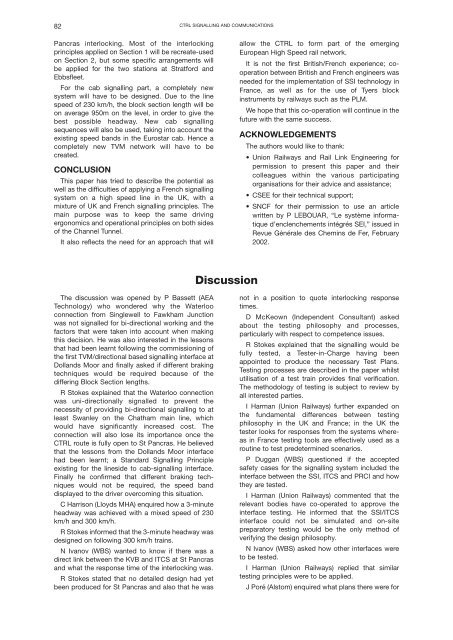Proceedings 2002/2003 - IRSE
Proceedings 2002/2003 - IRSE
Proceedings 2002/2003 - IRSE
You also want an ePaper? Increase the reach of your titles
YUMPU automatically turns print PDFs into web optimized ePapers that Google loves.
82<br />
CTRL SIGNALLING AND COMMUNICATIONS<br />
Pancras interlocking. Most of the interlocking<br />
principles applied on Section 1 will be recreate-used<br />
on Section 2, but some specific arrangements will<br />
be applied for the two stations at Stratford and<br />
Ebbsfleet.<br />
For the cab signalling part, a completely new<br />
system will have to be designed. Due to the line<br />
speed of 230 km/h, the block section length will be<br />
on average 950m on the level, in order to give the<br />
best possible headway. New cab signalling<br />
sequences will also be used, taking into account the<br />
existing speed bands in the Eurostar cab. Hence a<br />
completely new TVM network will have to be<br />
created.<br />
CONCLUSION<br />
This paper has tried to describe the potential as<br />
well as the difficulties of applying a French signalling<br />
system on a high speed line in the UK, with a<br />
mixture of UK and French signalling principles. The<br />
main purpose was to keep the same driving<br />
ergonomics and operational principles on both sides<br />
of the Channel Tunnel.<br />
It also reflects the need for an approach that will<br />
allow the CTRL to form part of the emerging<br />
European High Speed rail network.<br />
It is not the first British/French experience; cooperation<br />
between British and French engineers was<br />
needed for the implementation of SSI technology in<br />
France, as well as for the use of Tyers block<br />
instruments by railways such as the PLM.<br />
We hope that this co-operation will continue in the<br />
future with the same success.<br />
ACKNOWLEDGEMENTS<br />
The authors would like to thank:<br />
• Union Railways and Rail Link Engineering for<br />
permission to present this paper and their<br />
colleagues within the various participating<br />
organisations for their advice and assistance;<br />
• CSEE for their technical support;<br />
• SNCF for their permission to use an article<br />
written by P LEBOUAR, “Le système informatique<br />
d’enclenchements intégrés SEI,” issued in<br />
Revue Générale des Chemins de Fer, February<br />
<strong>2002</strong>.<br />
Discussion<br />
The discussion was opened by P Bassett (AEA<br />
Technology) who wondered why the Waterloo<br />
connection from Singlewell to Fawkham Junction<br />
was not signalled for bi-directional working and the<br />
factors that were taken into account when making<br />
this decision. He was also interested in the lessons<br />
that had been learnt following the commissioning of<br />
the first TVM/directional based signalling interface at<br />
Dollands Moor and finally asked if different braking<br />
techniques would be required because of the<br />
differing Block Section lengths.<br />
R Stokes explained that the Waterloo connection<br />
was uni-directionally signalled to prevent the<br />
necessity of providing bi-directional signalling to at<br />
least Swanley on the Chatham main line, which<br />
would have significantly increased cost. The<br />
connection will also lose its importance once the<br />
CTRL route is fully open to St Pancras. He believed<br />
that the lessons from the Dollands Moor interface<br />
had been learnt; a Standard Signalling Principle<br />
existing for the lineside to cab-signalling interface.<br />
Finally he confirmed that different braking techniques<br />
would not be required, the speed band<br />
displayed to the driver overcoming this situation.<br />
C Harrison (Lloyds MHA) enquired how a 3-minute<br />
headway was achieved with a mixed speed of 230<br />
km/h and 300 km/h.<br />
R Stokes informed that the 3-minute headway was<br />
designed on following 300 km/h trains.<br />
N Ivanov (WBS) wanted to know if there was a<br />
direct link between the KVB and ITCS at St Pancras<br />
and what the response time of the interlocking was.<br />
R Stokes stated that no detailed design had yet<br />
been produced for St Pancras and also that he was<br />
not in a position to quote interlocking response<br />
times.<br />
D McKeown (Independent Consultant) asked<br />
about the testing philosophy and processes,<br />
particularly with respect to competence issues.<br />
R Stokes explained that the signalling would be<br />
fully tested, a Tester-in-Charge having been<br />
appointed to produce the necessary Test Plans.<br />
Testing processes are described in the paper whilst<br />
utilisation of a test train provides final verification.<br />
The methodology of testing is subject to review by<br />
all interested parties.<br />
I Harman (Union Railways) further expanded on<br />
the fundamental differences between testing<br />
philosophy in the UK and France; in the UK the<br />
tester looks for responses from the systems whereas<br />
in France testing tools are effectively used as a<br />
routine to test predetermined scenarios.<br />
P Duggan (WBS) questioned if the accepted<br />
safety cases for the signalling system included the<br />
interface between the SSI, ITCS and PRCI and how<br />
they are tested.<br />
I Harman (Union Railways) commented that the<br />
relevant bodies have co-operated to approve the<br />
interface testing. He informed that the SSI/ITCS<br />
interface could not be simulated and on-site<br />
preparatory testing would be the only method of<br />
verifying the design philosophy.<br />
N Ivanov (WBS) asked how other interfaces were<br />
to be tested.<br />
I Harman (Union Railways) replied that similar<br />
testing principles were to be applied.<br />
J Poré (Alstom) enquired what plans there were for

















